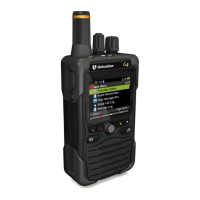Page 8
Figure 9:
C. The following is detailed explanation of the new settings for QCII over P25.
1. Binding Feature- There are three settings; None, Sub-Group Feature and Call Alert Feature. For
TGID paging “None” is selected, for QCII over P25 paging “Sub-Group Feature” is selected and
for Call Alert paging “Call Alert Feature” is selected.
2. Reset Mode- If the Binding Feature is set for “Sub-Group Feature" there are five selections.
a. Auto Reset- At the end of the page’s voice message the G4/5 goes back to Stand-By
mode awaiting another QCII page.
b. Selective Timeout Reset- This is similar to an analog pager’s Selective Call with Revert
mode. In this case, after the pager receives the QCII page’s message it will continue to
monitor TGIDs programmed in the Revert- Talk Group List until the Timeout Reset Timer
value expires. The pager will then go back to stand-by mode awaiting a QCII page.
c. Selective Manual Reset- Same as the above except one must depress the pager’s Reset
Key Button to cause the pager to return to the stand-by mode.
d. Monitor Timeout Reset-Monitors all TGIDs programmed Talk-Group List until the Timeout
Reset Timer value expires. If a TGID with QCII IDs is programmed in this list then upon
detection of a valid QCII ID the pager will monitor all TGIDs affiliated to the Site for the
duration of the Timeout Reset Timer.
e. Monitor Manual Reset- Same as the above except one must depress the pager’s Reset
Key Button to cause the pager to return to the stand-by mode.
3. Timeout Reset Timer- Works in conjunctions with the Timeout Reset Modes described above.
4. Delay N Function- This works similar to the Delay N function in analog paging. If there is a
drop-in carrier after Tone B being sent and the beginning of the associated voice message this
function ensures the voice message get stored.
5. Delay N Timer- Works in conjunction with the Delay N Function setting.

